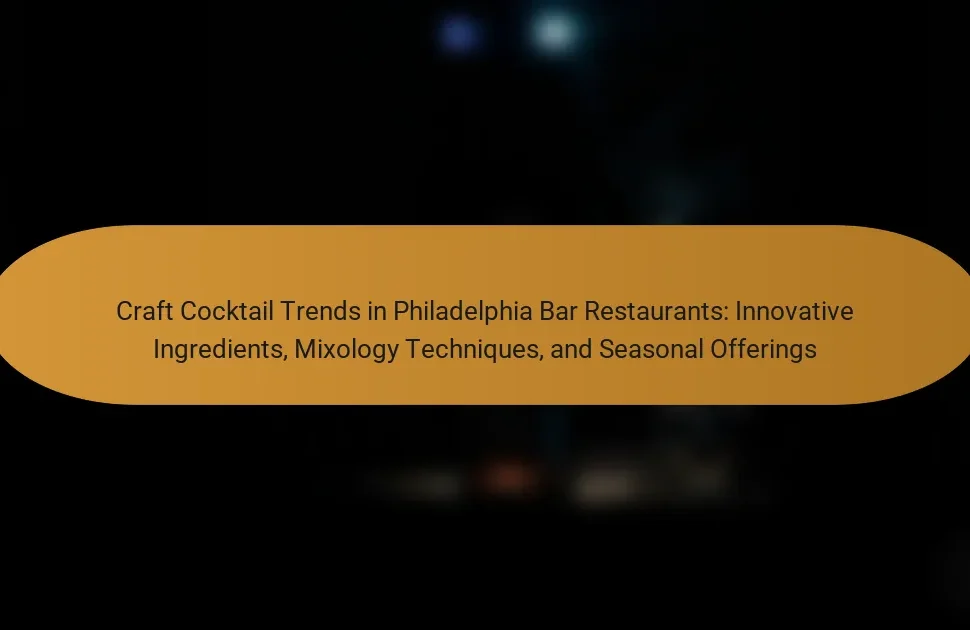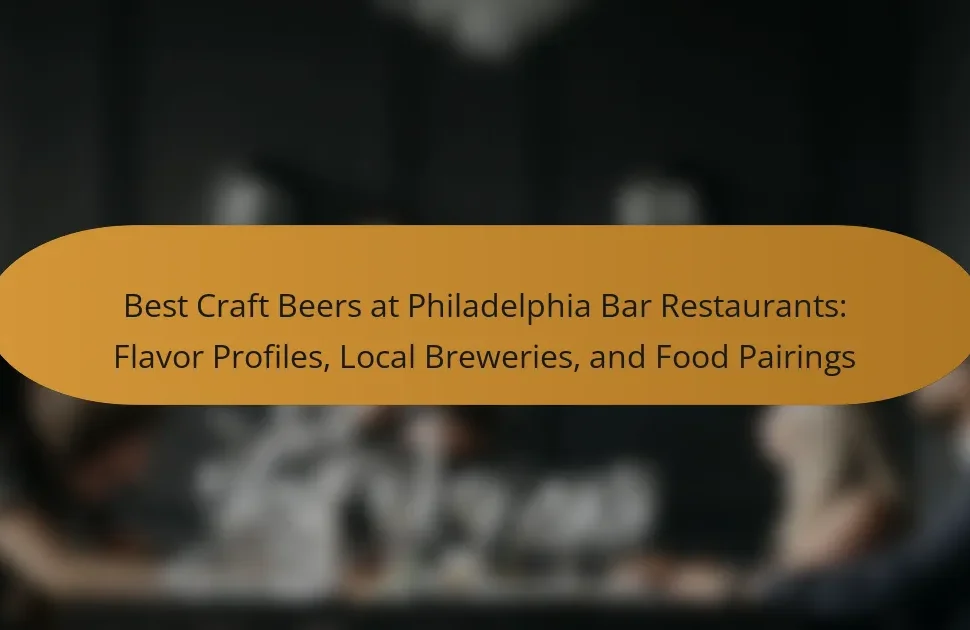
What is the history of Philadelphia bar restaurants?
Philadelphia bar restaurants have a rich and diverse history. They emerged in the 18th century as taverns serving food and drink to travelers and locals. The establishment of the city in 1682 led to an increase in social gathering places. By the 19th century, these establishments evolved into more structured bar restaurants, offering a wider variety of menu options.
Prohibition in the 1920s significantly impacted these venues, forcing many to close or operate illegally. After the repeal of Prohibition, bar restaurants began to flourish again. The late 20th century saw a shift towards gastropubs, combining high-quality food with a casual bar atmosphere.
Today, Philadelphia’s bar restaurants continue to innovate, reflecting culinary trends and local culture. They play a vital role in the city’s social and dining landscape, showcasing the evolution of food and drink in the region.
How have Philadelphia bar restaurants evolved over time?
Philadelphia bar restaurants have evolved significantly over time. Initially, they served primarily as taverns focused on alcohol sales and basic food options. In the late 19th century, the industrial boom led to the rise of beer gardens and establishments offering more diverse menus. The Prohibition era forced many bars to innovate, leading to the creation of speakeasies that often featured elaborate food offerings to attract patrons.
Post-Prohibition, the 1950s and 1960s saw a shift towards family-friendly dining, with bars adding more extensive menus to cater to a broader audience. The 1980s and 1990s introduced a craft beer movement, prompting bar restaurants to focus on local brews and gourmet food pairings.
In recent years, the trend has leaned towards farm-to-table concepts and unique culinary experiences. Many Philadelphia bar restaurants now emphasize local ingredients and artisanal preparations. The rise of social media has also influenced the evolution, as establishments seek to create visually appealing dishes that attract online attention.
This evolution reflects broader culinary trends, community engagement, and changing consumer preferences in Philadelphia.
What were the key historical milestones in the development of bar restaurants in Philadelphia?
The key historical milestones in the development of bar restaurants in Philadelphia include the establishment of the first taverns in the 18th century. These early taverns served as social hubs for colonists. The Pennsylvania Assembly passed laws in the 1750s regulating taverns, highlighting their importance. In the 19th century, the industrial revolution led to an increase in working-class patrons. This shift prompted the creation of more casual dining experiences. The Prohibition era (1920-1933) forced many establishments to adapt or close. After Prohibition ended, bars began to incorporate dining options more prominently. The late 20th century saw the rise of brewpubs, combining craft beer with restaurant dining. Today, Philadelphia’s bar restaurants reflect a diverse culinary scene influenced by various cultural trends.
How did cultural influences shape the evolution of these establishments?
Cultural influences significantly shaped the evolution of Philadelphia bar restaurants. Immigrant communities introduced diverse cuisines and dining practices. For example, Italian immigrants popularized pizza and pasta dishes in the early 20th century. African American culture contributed soul food and jazz music, enhancing the dining experience. The craft beer movement, influenced by local breweries, transformed bar menus in the 1990s. Events like the Philadelphia Folk Festival showcased regional foods and culinary traditions. These cultural exchanges fostered innovation in menus and restaurant concepts. Historical events, such as Prohibition, also prompted bars to adapt their offerings and atmospheres. Overall, cultural influences have continually enriched Philadelphia’s culinary landscape.
Who are the key figures in the history of Philadelphia bar restaurants?
Key figures in the history of Philadelphia bar restaurants include Henry Disston, who established the iconic Disston’s Restaurant in the late 19th century. His establishment set the standard for bar dining in the region. Another significant figure is Ralph L. C. Dorr, who opened the renowned Dorr’s Tavern in the early 20th century, known for its innovative menu and atmosphere. Additionally, the family-run McGillin’s Olde Ale House, founded in 1860 by the McGillin family, has been a staple in Philadelphia’s bar scene for over a century. Their contributions helped shape the culinary landscape of Philadelphia’s bar restaurants.
What contributions did notable chefs and restaurateurs make to the bar restaurant scene?
Notable chefs and restaurateurs significantly influenced the bar restaurant scene by introducing innovative culinary techniques and unique dining experiences. They elevated the quality of food served in bars, focusing on fresh, locally sourced ingredients. Their contributions included the creation of signature cocktails that paired well with food offerings. Many chefs also embraced the concept of gastropubs, blending fine dining with a casual atmosphere. This approach attracted a diverse clientele seeking both quality food and a relaxed environment. Additionally, restaurateurs often emphasized the importance of ambiance and service, enhancing the overall dining experience. Their efforts led to a cultural shift, where bars became recognized as legitimate dining destinations rather than mere drinking establishments. This transformation is evident in Philadelphia, where chefs have played a pivotal role in shaping the city’s vibrant bar restaurant landscape.
How did local entrepreneurs influence the growth of bar restaurants in Philadelphia?
Local entrepreneurs significantly influenced the growth of bar restaurants in Philadelphia by introducing innovative concepts and diverse cuisines. They capitalized on the city’s rich cultural heritage. This led to a unique blend of traditional and modern dining experiences. Many bar restaurants emerged in response to changing consumer preferences. Entrepreneurs focused on creating inviting atmospheres that encouraged social interaction. They also emphasized locally sourced ingredients, enhancing the appeal of their menus. The rise of craft beer culture further propelled the bar restaurant scene. By fostering community engagement, local entrepreneurs established a vibrant dining landscape in Philadelphia.
What culinary trends have emerged in Philadelphia bar restaurants?
Philadelphia bar restaurants have embraced several culinary trends in recent years. These include a focus on locally sourced ingredients. Many establishments now prioritize farm-to-table dining experiences. Craft cocktails have gained popularity, emphasizing unique flavors and artisanal spirits. Additionally, there is a rise in plant-based menu options, catering to vegan and vegetarian patrons. Bar snacks have evolved, with gourmet twists on classic items like pretzels and wings. The incorporation of global cuisines is also notable, reflecting the city’s diverse cultural landscape. Finally, a trend towards sustainability is evident, with many bars adopting eco-friendly practices and reducing waste.
How have food and drink pairings evolved in these establishments?
Food and drink pairings in Philadelphia bar restaurants have evolved significantly over time. Initially, establishments primarily served simple combinations, focusing on local beers and basic pub fare. As culinary trends progressed, chefs began to experiment with flavors and ingredients. The rise of craft beer in the early 2000s led to more thoughtful pairings with gourmet dishes. Today, many bars offer curated menus that highlight regional ingredients and innovative cocktails. This shift reflects a broader trend towards culinary sophistication and a growing appreciation for gastronomy. The evolution showcases how bars have transformed into dining destinations, emphasizing quality and experience.
What role does local sourcing play in the menus of Philadelphia bar restaurants?
Local sourcing plays a significant role in the menus of Philadelphia bar restaurants. It enhances the freshness and quality of ingredients used in dishes. Many establishments prioritize local farms and producers to support the community. This practice also reduces transportation costs and environmental impact. Local sourcing allows chefs to create seasonal menus that reflect regional flavors. Philadelphia’s culinary scene has embraced this trend, showcasing local meats, vegetables, and artisanal products. By highlighting local ingredients, bar restaurants can differentiate themselves and attract customers interested in sustainable dining. This approach fosters a connection between diners and the local food culture.
How do the historical aspects of Philadelphia bar restaurants connect to contemporary dining experiences?
Historical aspects of Philadelphia bar restaurants influence contemporary dining experiences through their culinary traditions and social culture. Many modern establishments draw inspiration from the region’s rich brewing history. The city’s taverns in the 18th century served as social hubs, a concept still prevalent today.
Traditional dishes, such as cheesesteaks and soft pretzels, originated in these early bars and remain popular menu items. The evolution of bar food reflects changes in societal tastes and dining expectations.
Notable figures, like George Washington, frequented Philadelphia’s taverns, highlighting their importance in American history. This legacy contributes to the city’s unique dining identity.
Moreover, contemporary bar restaurants often incorporate local ingredients, honoring the farm-to-table movement that has roots in historical practices. The blend of history and modernity creates a distinctive dining experience in Philadelphia today.
What are the current challenges facing Philadelphia bar restaurants?
Philadelphia bar restaurants currently face several challenges. Labor shortages are significant, affecting service quality and operational efficiency. Rising food and supply costs put pressure on profit margins. Increased competition from new establishments complicates market positioning. Regulatory changes, including health and safety guidelines, require constant adaptation. Additionally, fluctuating consumer preferences demand innovative menu offerings. Economic uncertainty impacts customer spending habits, leading to decreased foot traffic. These challenges require strategic responses to ensure sustainability and growth in the industry.
What tips can enhance the experience at Philadelphia bar restaurants?
To enhance the experience at Philadelphia bar restaurants, consider visiting during off-peak hours for a more relaxed atmosphere. Engaging with staff can lead to personalized recommendations and specials. Exploring local craft beers can deepen your appreciation for Philadelphia’s brewing culture. Sharing dishes encourages trying diverse menu options. Participating in events like trivia nights fosters community interaction. Checking for happy hour deals can provide cost-effective enjoyment. Lastly, leaving feedback can help improve service and offerings.
How can patrons choose the best bar restaurant for their preferences?
Patrons can choose the best bar restaurant for their preferences by evaluating several key factors. First, they should consider the menu offerings. A diverse menu can cater to various tastes. Second, patrons should assess the ambiance and decor. The atmosphere can significantly enhance the dining experience. Third, location is crucial. A convenient location can influence repeat visits. Fourth, customer reviews provide insights into service quality. High ratings often indicate a reliable choice. Fifth, patrons should examine drink options. A well-curated drink menu can elevate the dining experience. Lastly, special events or promotions can attract patrons looking for unique experiences. These factors collectively help patrons make informed decisions about bar restaurants.
What are the must-try dishes and drinks when visiting Philadelphia bar restaurants?
The must-try dishes and drinks when visiting Philadelphia bar restaurants include the iconic cheesesteak, soft pretzels, and water ice. The cheesesteak is made with thinly sliced beef and melted cheese on a hoagie roll. It is a staple of Philadelphia cuisine and often served with onions or peppers. Soft pretzels are a popular snack, typically served warm and salted. They are often enjoyed with mustard for dipping. Water ice is a refreshing frozen dessert made from flavored ice, perfect for hot days.
As for drinks, the local craft beer scene is vibrant, featuring many breweries in the area. Popular choices include IPAs and stouts from Philadelphia breweries. Additionally, a classic cocktail to try is the Philadelphia Fish House Punch, which has historical roots in the city. These dishes and drinks reflect Philadelphia’s unique culinary heritage and are essential for any visitor.
The main entity of this article is Philadelphia bar restaurants, which have a rich history dating back to the 18th century. The article outlines their evolution from early taverns to modern establishments, highlighting key historical milestones, cultural influences, and notable figures that shaped the scene. It also discusses current culinary trends, the importance of local sourcing, and the challenges faced by these venues today. Additionally, it provides tips for patrons on enhancing their dining experience and identifies must-try dishes and drinks that reflect Philadelphia’s unique culinary heritage.




